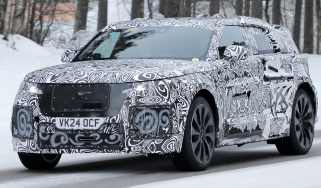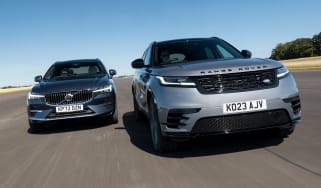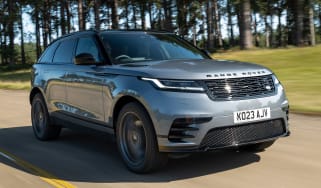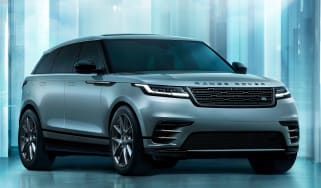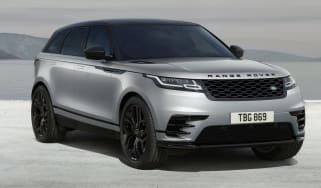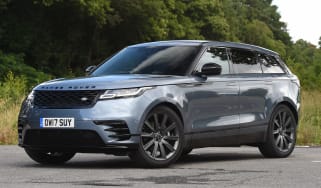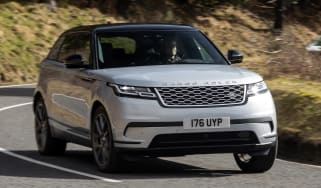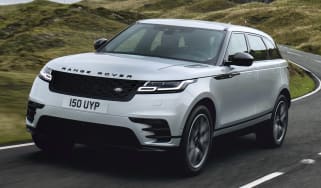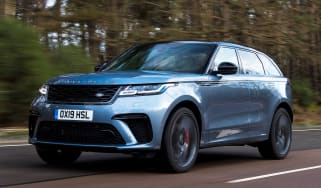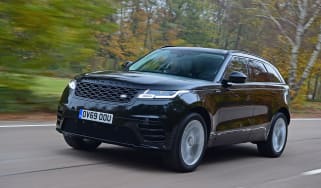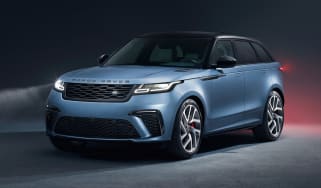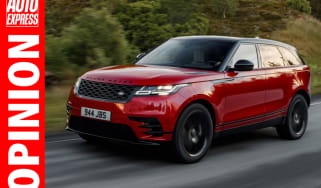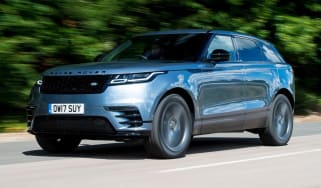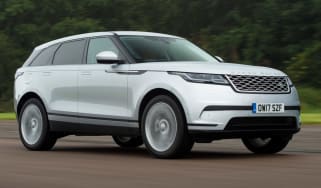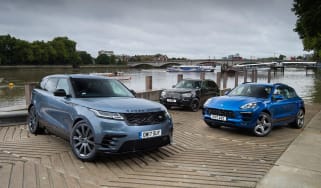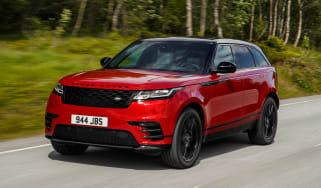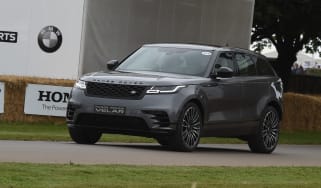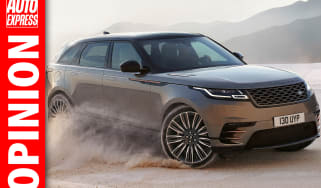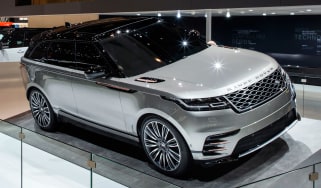Range Rover Velar review
Offering plenty of kerb appeal, the stylish Range Rover Velar is a desirable alternative to its premium mid-size SUV rivals

The Range Rover Velar is a supremely stylish SUV that offers the level of comfort and refinement you’d expect from any car that bears the Range Rover name. There’s a good selection of engines, including a plug-in hybrid that’ll appeal to company car drivers, and for a car of this size, the Velar is surprisingly decent to drive.
However, the Velar’s interior is something of a mixed bag. It’s spacious, well finished and features JLR’s excellent Pivi Pro infotainment system from its flagship Range Rover and Range Rover Sport models. But the updated SUV heavily prioritises form over function, ditching physical controls for the sake of an uber-minimalist look, and can only carry four people comfortably.
About the Range Rover Velar
The rakishly elegant Range Rover Velar is JLR’s entry into the premium mid-size SUV segment, and so must do battle with a variety of highly-rated competitors including our current favourite in this class – the Lexus NX – as well as the Audi Q5, BMW X3 and all-electric iX3, Mercedes GLC, Porsche Macan, Volvo XC60 and Jaguar’s own F-Pace.
But the Velar’s tapered roofline and elegant rear quarters are clearly not designed for maximum practicality like its boxier rivals. It’s also the closest model in the Range Rover lineup to a coupe-SUV, meaning it must contend with the likes of the Audi Q5 Sportback, BMW X4 and Mercedes GLC Coupe, too.
Used - available now

2020 Land Rover
Range Rover Velar
30,340 milesAutomaticDiesel2.0L
Cash £23,395
2023 Land Rover
Range Rover Velar
42,521 milesAutomaticDiesel2.0L
Cash £29,920
2022 Land Rover
Range Rover Velar
27,876 milesAutomaticPetrol3.0L
Cash £37,990
2020 Land Rover
Range Rover Velar
36,926 milesAutomaticDiesel2.0L
Cash £29,495The Velar’s interior is spacious, lavishly equipped, comfortable and features the latest technology JLR has to offer, although you’ll immediately notice the highly minimalist approach to its cabin design that could almost be described as Tesla-like. The only controls found on the new centre console are the gear selector and hazard-warning switch, with everything else moved to the central touchscreen.
Every model features an automatic gearbox and four-wheel drive, but there is a wide range of different engines available, including petrol, diesel and plug-in hybrid powerplants. Diesel options include the entry-level D200 four-cylinder with 201bhp, followed by a 3.0-litre six-cylinder producing 296bhp, badged D300.
Petrol options kick off with a 247bhp 2.0-litre four-cylinder badged as the P250, while the more powerful P400 pumps out 394bhp from its 3.0-litre six-cylinder. The P250 is the only one of the four engines that doesn’t feature mild-hybrid technology.
If you want a stepping stone to living with an electric car, or are on the hunt for a stylish SUV for your next company car, then the plug-in hybrid P400e combines a 2.0-litre petrol engine and electric motor for a 398bhp total power output, plus a pure-electric driving range of up to 40 miles. There’s no EV version of the Velar unfortunately, but we have learned that the next-generation model will be all-electric.
If you're looking for a 296bhp P300 model, or the 542bhp SVAutobiography Dynamic Edition (badged P550), then it'll have to be a used example, as both have been removed from the Velar price list.
There are currently four trim levels to choose from: S, Dynamic SE, Dynamic HSE and Autobiography. Every Velar is equipped with alloy wheels (starting at 19 inches), a fixed panoramic roof, LED headlights, leather upholstery, heated front seats, a 12.3-inch digital driver’s display, 11.4-inch Pivi Pro touchscreen, wireless Apple CarPlay and Android Auto connectivity, a rear-view camera and several driver-assistance systems. Pricier models add larger wheels (20 to 22 inches), more aggressive styling, upgraded leather upholstery, a Meridian sound system and Pixel LED lights.
How much does the Range Rover Velar cost?
Prices start from around £54,000, and just In case you’re wondering about the Velar name, it goes all the way back to the 1960s when it was used as an alias to disguise original Range Rover prototypes. It’s derived from the Italian verb ‘velare’ meaning ‘to veil or cover’.
Engines, performance and drive
The Velar features Active Road Noise Cancellation technology. Essentially, by producing frequencies from the speakers at an opposing amplitude to the tyre and road noise, the brand says it reduces road roar inside the cabin to class-leading levels. What we can say for sure is that the Velar is a relaxing place to be on a long drive.
The ride is impressively smooth at both low and high speeds, with very little in the way of vibration entering the cabin. There’s a good level of control that enables the Velar to feel stable and reassuring on a long-distance cruise, and prevent occupants from getting thrown from side to side when cornering, yet the compliant suspension is able to filter out the worst surfaces and harshest bumps of British roads.
But as well as being refined and comfortable, the Velar is also fairly good fun to drive for a car of this size, thanks to its meaty steering, balanced chassis and composure through the corners. And despite the all-weather tyres our test car was riding on, there’s plenty of grip available.
The ride is made even more comfortable if you opt for the smaller alloys, however the Velar looks fantastic on larger wheels, and we think some people will tolerate a small amount of discomfort in order to get that perfect look on the road and when parked up.
0-62mph acceleration and top speed
The Velar used to be offered with the same supercharged 5.0-litre V8 as the Jaguar F-Pace SVR, which could do 0-62mph in 4.5 seconds and hit 170mph flat out. That fire-breathing version of the Velar is no longer available though, meaning the quickest member of the lineup is now the P400e plug-in hybrid.
The P400e’s combination of a 2.0-litre four-cylinder petrol engine and electric motor produces a combined 398bhp and 640Nm; enough for 0-62mph in 5.4 seconds and a top speed of 130mph. When you’re driving in electric mode, the Velar PHEV feels like it’s struggling to shift itself along. Ask for some extra oomph by pushing the accelerator pedal harder, and the four-cylinder unit bursts into life and fires you towards the horizon at a rapid rate. Things actually become smoother when the four-pot petrol engine is doing all the work, but that defeats the point of having the hybrid in the first place.
Our preferred method of propulsion is the 296bhp D300 diesel, as the smooth and torquey six-cylinder is a perfect match for the Velar’s character. Admittedly, it’s not as quick as the plug-in hybrid, with 0-62mph in this version taking 6.5 seconds. Top speed goes up to 143mph for the D300, however.
Meanwhile the entry-level D200 diesel, which uses a 201bhp four-cylinder engine, takes 8.3 seconds to complete the same benchmark sprint, and also has a top speed of 130mph.
If you’re not a fan of diesels, the Velar is available with two petrol engines: the 247bhp P250 four-cylinder and the 394bhp P400 six-cylinder. The four-pot can propel the Velar to 62mph in 7.5 seconds and up to 135mph, while the P400 requires just 5.5 seconds to reach 62mph before topping out at 155mph.
MPG, CO2 and running costs
The Range Rover Velar is different from some of the more attainable Land Rover models, such as the Evoque and Discovery Sport, because there is no front-wheel drive version offered. Even the entry-level diesel is 4WD only, which fits with the car’s high-end target market.
The D200 and D300 diesels both feature mild-hybrid technology to help boost efficiency ever so slightly over those without any hybrid assistance. According to JLR, the D200 engine can return between 40.4-44.1mpg across a mixture of driving conditions, while the more powerful D300 will return 36.7-39.2mpg on average.
CO2 emissions range from 168-183g/km for the D200 and 188-202g/km for the D300, again in mixed driving conditions.
The P250 petrol engine is the only one in the Velar range that doesn’t utilise hybrid technology, with the 2.0-litre four-cylinder unit offering average fuel economy figures of 28.5-30.7mpg. The least efficient model in the lineup is the P400 petrol – JLR says the six-cylinder mild-hybrid, with its 394bhp, will return between 27.7-29.4mpg on average. CO2 emissions also increase slightly from 211-226g/km for the P250, up to 219-232g/km in the P400.
The P400e plug-in hybrid is one to go for if you want maximum fuel economy or are hunting for your next premium company car. The Velar PHEV combines a 2.0-litre four-cylinder petrol engine with a 141bhp electric motor, which draws its energy from a 19.2kWh battery (although only 15.4kWh of that is usable). Because this version can cover a decent amount of miles without using a drop of petrol, JLR says it can average 176.6mpg, but you’ll really need to exploit its EV mode to get anywhere near this figure in real-world driving.
Nevertheless, it remains impressive economy compared to the rest of the Velar lineup, but Mercedes claims the plug-in versions of its latest GLC Coupe will average between 565-700+mpg, so it’s not the only PHEV that offers superior efficiency. We didn’t find the plug-in Velar to be very frugal once its battery runs dry, either. On longer trips you will struggle to get much above 30mpg out of the P400e, while a Lexus NX 450h+ will get closer to 50mpg with an empty battery.
Other plug-in hybrid SUVs emit less CO2 than the P400e as well. But the 40g/km coming out of the Velar PHEV means it attracts an 8 per cent Benefit-in-Kind (BiK) company car tax rate, while the diesel models sit in the 37 per cent band.
Electric range, battery and charging
The next-generation Range Rover Velar will be all-electric, but for now the best option for those wanting improved efficiency is the P400e plug-in hybrid. The Velar PHEV uses a 19.2kWh battery that allows for an official range of 38-40 miles, depending on the specification. But based on our experience, you’ll cover closer to 30 miles in EV mode before the battery runs out of juice.
Speaking of which, the Velar is one of the few PHEVs with rapid-charging capabilities. Plug the Velar P400e into a 50kW rapid charger and a 0-80 per cent top-up only requires 30 minutes. We expect most people will charge the car at home however, with a typical 7kW home wallbox able to fully replenish the Velar’s battery in two and a half hours.
Insurance groups
The Velar’s insurance ratings are on par with those for the BMW X4, Mercedes GLC Coupe and Porsche Macan, which is a solid achievement when you consider the Velar’s cost and desirability. The entry-level diesel sits in group 36 (out of 50), while the range-topping Autobiography P400 mild-hybrid climbs all the way to group 47.
Check if your car needs an MoT and view its complete history with our MoT History Checker...
Depreciation
Our latest expert data suggests that the Velar should retain between 59 and 65 per cent of its original value over three years and 36,000 miles. The Porsche Macan is projected to hold onto roughly the same amount (62-66 per cent) come trade-in time, while the Mercedes GLC should retain around 52-58 per cent of its list price.
To get an accurate valuation on a specific model check out our free car valuation tool...
Interior, design and technology
The Range Rover Velar was launched in 2017 and designed by Gerry McGovern – the man responsible for the new Defender, Range Rover and Range Rover Sport. When it hit the streets, the Velar looked more like a concept car than anything else, thanks to its clean, modern and uncluttered styling. It’s still an excellent looking SUV, even after six years on showroom floors, so no wonder not much changed when the Velar was given a mid-life refresh in 2023.
In terms of styling revisions, the Velar got a fresh grille design, a new LED headlight signature (on certain models) and a reprofiled rear bumper – and that’s pretty much it. It was the cabin that received the much more significant overhaul.
The Velar’s original interior was already pretty minimalist, and featured a three-screen setup. But now the brand has decided to take a leaf out of Tesla’s book, and has removed every physical button and switch from the dashboard except for the gear selector and hazard-warning button. It’s a mix which has come at the expense of usability in a few instances, as the climate controls have moved from a separate screen with physical dials to the central screen.
The large, blank panel that occupies the space where the climate controls used to be is available with a couple of different finishes, but our test car simply featured a piece of satin-finish plastic. The arrangement doesn’t look very high quality, which is a shame because otherwise the cabin feels well finished and sturdy.
The new chunky steering wheel is great to hold and features neat rotary controls and sturdy-feeling column stalks just behind, while the large 12.3-inch digital driver’s display certainly looks sharp, and it presents plenty of information that’s easy to read.
Sat-nav, stereo and infotainment
New for 2023, the Velar gains the same version of JLR’s Pivi Pro infotainment system that features on the flagship Range Rover and Range Rover Sport models. The gently curved 11.4-inch display sits slightly proud of the dashboard, which makes it a little easier to reach on the move.
It’s an impressive setup: the large screen is bright and the graphics are very sharp, the menus are logical and well laid out, and loading times and touch responses are quick. However, the change to the new display has removed the physical climate controls. Now, there are on-screen adjustments, and while they’re fairly easy to access via temperature shortcuts at the base of the screen, put simply, it’s just a more fiddly solution than what was there before, so ergonomics have taken a backward step.
Wireless Apple CarPlay and Android Auto both come as standard, along with the Online Pack that gives you access to Amazon’s Alexa virtual assistant and Spotify music streaming.
Practicality, comfort and boot space
The Velar sits between the compact Evoque and the Range Rover Sport – our reigning Large Premium SUV of the Year – and as such its dimensions fall neatly between the two models. It’s a very roomy SUV, but not the best option for those who regularly carry three passengers in the rear – for reasons we’ll get into shortly. If you just need room for four though, the Velar is an excellent option.
Boot space is equally generous, but cabin storage is average – there’s a large glovebox, the door bins are fairly deep and the central storage bin is reasonably roomy, although it’s not that wide. As a result, it’s a bit of a squeeze to fit a large smartphone inside – especially if you choose to plug it into one of the USB sockets. There’s also a 12-volt socket in the same cubby. Rear passengers also get a set of USB-C charging ports to keep their devices topped up, with two sets of ISOFIX mounting points back there for child seats as well.
Dimensions and size
The Range Rover Velar measures in at 4,797mm long, 2,041mm wide and 1,683mm tall. In other words, it’s about the same length as a Porsche Macan, but the Velar is taller and wider. The Velar is relatively easy to get into compared to larger Range Rovers thanks to its lower driving position, and if you go for Dynamic HSE trim or above, the air suspension can go into ‘Auto Access’ mode that lowers the car by 40mm when you reach your destination, making it even easier to get into and out of.
Leg room, head room & passenger space
Sitting up front in the Velar is not quite as majestic as the large Range Rovers, but you still get a commanding view of the road ahead and it’s very easy to get comfortable. There’s also plenty of adjustment in the supportive seats as well as in the steering column, so finding a good driving position is no problem.
Meanwhile in the rear, there’s a very impressive amount of kneerom and the cabin itself is wide, plus the two outer seats are nicely sculpted, making it very easy for two six-foot adults to get comfortable. However the Velar is best suited for carrying two in the back, rather than three, as the centre seat is quite slim, the backrest is hard, and the central tunnel is quite high, so there’s little space for the middle passenger’s feet.
Boot space
Petrol and diesel-powered Velars have a 552-litre boot, while the plug-in hybrid offers 503 litres of space because of the battery located under the boot floor. Nevertheless, the load bay is almost perfectly square, and the large boot opening makes it easy to stack items inside. You get four hooks to tie things to, while a sturdy load-lip protector means you don’t have to worry too much about causing damage when lifting heavy luggage in. Unfortunately, unlike in the Range Rover there’s no split-tailgate.
Every Velar features a 40:20:40 split rear bench, and dropping the rear seats expands the luggage capacity to 1,358 litres in petrol and diesel models, or 1,335 litres in the plug-in hybrid.
Towing
The Velar’s towing capacity depends on which engine you select. The plug-in hybrid P400e can haul up to 2,000kg, the cheaper D200 and P250 can tow up to 2,400kg, while the more powerful D300 diesel and P400 petrol have a maximum towing capacity of 2,500kg. However, all Velars can only tow up to 750kg on an unbraked trailer.
Reliability and safety
The Range Rover Velar uses plenty of tried and tested parts, as well as the same platform as cars like the Jaguar F-Pace, so any potentially serious issues should have been ironed out by now.
The Velar didn’t make it onto our most recent list of the best cars to own, which is based on owners’ feedback from our Driver Power customer satisfaction survey. However the closely related F-Pace finished 50th (out of 75 cars) on the list, while the Land Rover Discovery Sport and Range Rover Evoque came 49th and 73rd, respectively.
Meanwhile Land Rover finished in 14th place (out of 32) in our best car manufacturer rankings, ahead of rival premium brands such as BMW, Audi and Mercedes.
Safety should be pretty good as the Velar received Euro NCAP’s maximum five-star crash safety rating when it was tested in 2017. Its seriously impressive 93 per cent adult occupancy score was bolstered by a 85 per cent child occupant score and a 72 per cent safety assist result.
Even in the pedestrian impact category, where one might imagine a relatively tall SUV would fare poorly, the Velar was awarded a 72 per cent score. This result was, in part, down to the Velar's autonomous emergency braking (AEB) system, which detected and avoided pedestrians in all its assessments.
Warranty
The Range Rover Velar comes with a three-year unlimited mileage warranty, which is on par with rivals. A BMW X5 offers the same warranty, but an Audi Q7’s warranty is limited to 60,000 miles.
Servicing
Land Rover offers individual service plans for the Velar, allowing you to spread the cost or make a one-off payment.






